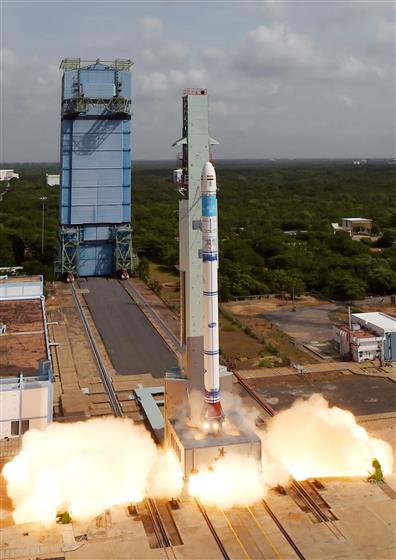India Achieves Major Milestone with Successful SSLV-D3 Launch
Prime Minister Narendra Modi today congratulated the scientists of the Indian Space Research Organisation (ISRO) on the successful launch of the new Satellite Launch Vehicle (SSLV)-D3. Modi highlighted that the cost-effective SSLV will play a crucial role in future space missions and encourage greater involvement from the private sector.
In a post on X, Modi stated, "A remarkable milestone! Congratulations to our scientists and industry for this feat. It is a matter of immense joy that India now has a new launch vehicle. The cost-effective SSLV will play an important role in space missions and will also encourage private industry. My best wishes to ISRO, INSPACe, NSIL, and the entire space industry."
ISRO's latest Earth Observation Satellite, EOS-08, was launched by the SSLV-D3 today at 9:17 hrs from the Satish Dhawan Space Centre in Sriharikota. The primary objectives of the EOS-08 mission include the design and development of a microsatellite, the creation of payload instruments compatible with the microsatellite bus, and the incorporation of new technologies essential for future operational satellites.
Built on the Microsat/IMS-1 bus, EOS-08 carries three payloads: the Electro Optical Infrared Payload (EOIR), the Global Navigation Satellite System-Reflectometry payload (GNSS-R), and the SiC UV Dosimeter. The EOIR payload is designed to capture images in the Mid-Wave IR (MIR) and Long-Wave IR (LWIR) bands, both during day and night, for applications such as satellite-based surveillance, disaster monitoring, environmental monitoring, fire detection, volcanic activity observation, and industrial disaster monitoring.
The GNSS-R payload demonstrates the capability of using GNSS-R-based remote sensing for applications like ocean surface wind analysis, soil moisture assessment, cryosphere studies over the Himalayan region, flood detection, and inland waterbody monitoring. Meanwhile, the SiC UV Dosimeter monitors UV irradiance at the viewport of the Crew Module in the Gaganyaan Mission and serves as a high-dose alarm sensor for gamma radiation.
The spacecraft is configured to operate in a Circular Low Earth Orbit (LEO) at an altitude of 475 km with an inclination of 37.4°, and has a mission life of one year. The satellite has a mass of approximately 175.5 kg and generates around 420 W of power, interfacing seamlessly with the SSLV-D3 launch vehicle.
EOS-08 marks a significant advancement in satellite mainframe systems, featuring an Integrated Avionics system known as the Communication, Baseband, Storage, and Positioning (CBSP) Package. This package combines multiple functions into a single, efficient unit and supports up to 400 Gb of data storage. The satellite includes a structural panel embedded with a PCB, an embedded battery, a Micro-DGA (Dual Gimbal Antenna), an M-PAA (Phased Array Antenna), and a flexible solar panel, each serving as key components for onboard technology demonstration.
The satellite employs a miniaturised design in its Antenna Pointing Mechanisms, capable of achieving a rotational speed of 6 degrees per second and maintaining a pointing accuracy of ±1 degree. The miniaturised phased array antenna further enhances communication capabilities, while the flexible solar panel offers improved power generation and structural integrity. A pyrolytic graphite sheet diffuser plate, known for its high thermal conductivity of 350 W/mK, reduces mass and finds application in various satellite functions. The EOS-08 mission also adopts a new method of integrating housekeeping panels using a hinge-based fixture, significantly reducing the duration of the Assembly, Integration, and Testing (AIT) phase.
Incorporating novel schemes, the EOS-08 mission advances satellite technology through X-band data transmission, using pulse shaping and Frequency Compensated Modulation (FCM) for X-Band data transmitters. The satellite’s battery management system employs SSTCR-based charging and bus regulation, sequentially managing strings at a frequency of 6 Hz.
The mission’s indigenisation efforts are evident in its solar cell fabrication processes and the use of a Nano-Star Sensor for Microsat Applications. Additionally, the inertial system benefits from reaction wheel isolators that attenuate vibrations, and a single antenna interface is used for TTC and SPS applications. Thermal management is enhanced using materials like AFE BGA, Kintex FPGA, Germanium Black Kapton, and STAMET (Si-Al Alloy) Black Kapton to manage the thermal properties of COTS components. The mission also features an auto-launch pad initialization feature, further demonstrating its commitment to innovative mission management.
With this launch, India not only strengthens its space capabilities but also solidifies its position as a global leader in cost-effective space technology, paving the way for future advancements in the industry


